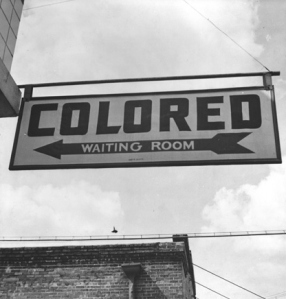Take a few moments to carefully examine the photo below. Here, we see an African-American man drinking from a water can that is labeled “colored”. To both sides of him there are signs that indicate two separate restrooms for men and women: one for white and one for “colored”. The seperate-but-equal doctrine not only allowed, but justified racial segregation. A scene like this one was typical of the everyday lives of southern African-Americans. Drinking fountains and restrooms were not the only places for segregation. There were separate schools, movie theaters, restaurants, stores, and churches for African-Americans. It was also a common practice to refuse service to customers based solely on race. Buses on the other hand transported both white and “colored” passengers; however, they had a divider where the African-American passengers were required to sit in the back of the bus. After looking at this photo, what thoughts come to mind? What sort of feelings arise? What would your reaction be if you saw this kind of scene today? Is there anything else you see that is not shown in the picture? In a few sentences, briefly write your reflections below in the comments section.
Tag Archives: Assignments
A Diary of Segregation
 You are an African-American teenager living in the South during the 1950’s. Segregation is very much embedded in the American mindset. Write a diary entry that describes what is happening around you in your everyday life. Write what you are reading in the newspapers, listening to on the radio, or watching on television that pertains to segregation. Write your entry in the comments section below. Your entry is to be a minimum of 150 words. Begin your entry with the traditional “Dear Diary,” and be sure to write the date of when you are writing the entry (i.e., December 5, 1957). Keep in mind the historical accuracy of the date from which you are writing from and the chronology of the events that occurred in the 1950’s. (So for example, you would not write about Brown v. Board of Education if your entry was dated June 12, 1952). Below are a few questions to help get you started:
You are an African-American teenager living in the South during the 1950’s. Segregation is very much embedded in the American mindset. Write a diary entry that describes what is happening around you in your everyday life. Write what you are reading in the newspapers, listening to on the radio, or watching on television that pertains to segregation. Write your entry in the comments section below. Your entry is to be a minimum of 150 words. Begin your entry with the traditional “Dear Diary,” and be sure to write the date of when you are writing the entry (i.e., December 5, 1957). Keep in mind the historical accuracy of the date from which you are writing from and the chronology of the events that occurred in the 1950’s. (So for example, you would not write about Brown v. Board of Education if your entry was dated June 12, 1952). Below are a few questions to help get you started:
What are the everyday struggles you encounter?
What do you see about your daily life that differs from white teenagers?
What are your thoughts on “separate-but-equal”? How equal is it?
What are some of the major events/people/topics that are attracting media attention?
What changes would you like to see take place concerning racial segregation?
